1.
2.
3.
4.
5.
6.
7.
In the last decade, new models of heating equipment, including radiators, have appeared on the domestic market, but cast iron products are still in demand among consumers. They are produced by both Russian and foreign manufacturers. The cast iron heating radiators shown in the photo are one of the elements of arranging the heat supply of an apartment or your own house.
What is heat dissipation and power of radiators
Power cast iron radiators heating and their heat transfer are the main characteristics of any device that provides heating of the room. Usually equipment manufacturers for heating structures indicate this parameter for one battery section, and the required number is calculated based on the size of the room and the required one.In addition, other factors are taken into account, such as, for example, the volume of the room, the presence of windows and doors, the degree of insulation, the characteristics of climatic conditions, etc. depends on the material of their manufacture. It should be noted that cast iron loses in this issue to aluminum and steel. The thermal conductivity of this material is 2 times lower than that of aluminum. But this disadvantage compensates for the low inertness of cast iron, which gains heat and gives it away for a long time.
In closed heating systems with forced circulation the efficiency of aluminum batteries will be much higher, but subject to the presence of an intense coolant flow. For open structures, cast iron has more advantages in natural circulation.
The approximate power of one section of a cast-iron radiator is 160 watts, while for aluminum and bimetallic devices, the same parameter is within 200 watts. Therefore, under equal operating conditions, a cast iron battery must have a large number of sections.
The procedure for calculating the number of sections
There are different methods for performing technical calculations for radiators. Precise algorithms allow calculations to be made taking into account many factors, including the size and location of the room in the building. You can also use a simplified formula that will allow you to find out the desired value with sufficient accuracy. So, you can calculate the number of sections by multiplying the area of \u200b\u200bthe room by 100 and dividing the result by the power of the cast-iron radiator section in cotton wool.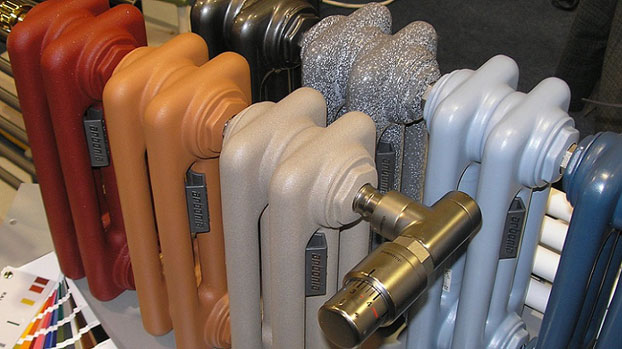
- in the event that the total is a fractional number, round it up. The heat margin is better than its lack;
- when the room has not one, but several windows, install two batteries, dividing the required number of sections between them. As a result, not only the service life of the radiators increases, but also their maintainability. Batteries will be a good barrier to cold air coming from windows;
- if the ceiling height in the room is more than 3 meters and there are two external walls in order to compensate for heat losses, it is advisable to add a couple of sections and thereby increase the power of the cast-iron heating radiator.
Dimensions and weight of cast iron heating radiators
The parameters of cast iron radiators using the example of the domestic product MC-140 are as follows:- height - 59 centimeters;
- section width - 9.3 centimeters;
- section depth - 14 centimeters;
- section capacity - 1.4 liters;
- weight - 7 kilograms;
- section power 160 watts.
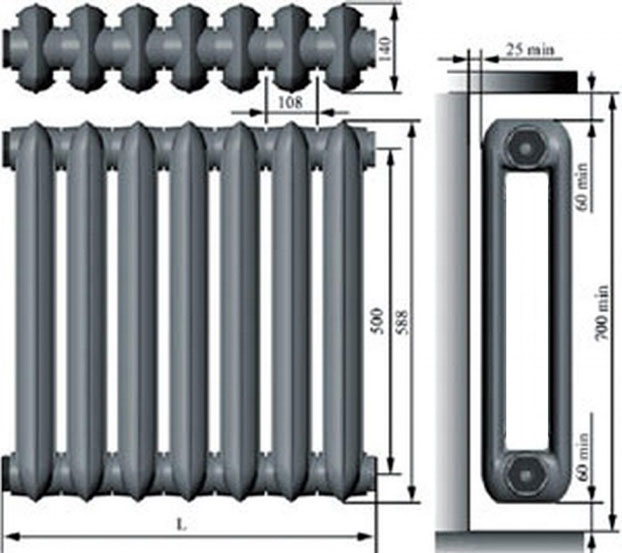
From the side of real estate owners, you can hear complaints that it is quite difficult to transfer and install radiators consisting of 10 sections, the weight of which reaches 70 kilograms, but I am glad that such work in an apartment or house is done once, so it is necessary to calculate correctly.
Since the amount of coolant in such a battery is only 14 liters, then when heat energy comes from the boiler autonomous heating system, then you will have to pay for extra kilowatts of electricity or cubic meters of gas.
Service life of cast iron radiators
In terms of such indicators as the duration of operation and sensitivity to temperature and quality of the coolant, cast iron radiators are ahead of other types of batteries. Which is quite understandable: cast iron is characterized by resistance to abrasive wear and the fact that it does not enter into any chemical reactions with the materials from which pipes and elements of heating boilers are made.The dimensions of the channels passing through the cast iron batteries are sufficient to ensure that the devices are minimally clogged. As a result, they do not require cleaning work. According to experts, modern cast iron radiators can last from 30 to 40 years. But one cannot fail to say about the big drawback of this product - it is poor tolerance of water shocks.
Working and pressure test
Among technical characteristics besides the fact that the power of cast iron heating radiators is important, mention should be made of the pressure indicators. Typically, the working pressure of the heat transfer fluid is 6-9 atmospheres. Any types of batteries with such a pressure parameter can cope without problems. The nominal pressure for cast iron products is exactly 9 atmospheres.In addition to the working pressure, the concept of "pressure" pressure is used, reflecting its maximum allowable value that occurs during the initial start-up of the heating system. For the cast iron model MS-140, it is 15 atmospheres.

According to the regulations, in the process of starting the heating system, it is necessary to check the ability to smoothly start the centrifugal pumps, which should operate in automatic mode, but in reality everything is far from being as it should be.
Unfortunately, in most homes, automation is either missing or faulty. But the instruction for carrying out this type of work provides that the initial start-up should be performed with the valve closed. It is allowed to open smoothly only after equalizing the pressure in the heating medium supply line.
But utility workers do not always follow instructions. As a result, in case of violation of the regulations, a water hammer occurs. With it, a significant jump in pressure leads to an excess of the permissible pressure value and one of the batteries located along the path of the coolant is not able to withstand such a load. As a result, the service life of the device is significantly reduced.
Coolant quality for cast iron radiators
As noted earlier, for cast iron radiators, the quality of the heat transfer fluid does not matter. These devices do not care about pH or other characteristics. At the same time, foreign impurities, such as stones and other debris, present in municipal heating systems, pass without hindrance through fairly wide channels of the batteries and are transported further. Often they find themselves in narrow holes of steel inserts in bimetallic radiators from neighbors. Naturally, over time, the power of the cast-iron radiator section decreases.If a private house is used autonomous system heat supply, it does not matter what kind of coolant will be used - water, antifreeze or antifreeze. Before using water as a heat carrier, the property owner needs to prepare it, otherwise the heating boiler, hydraulic group or heat exchanger will quickly fail (read: ""). The output of the heating unit may also drop.
Radiator housing
Cast iron radiators are sold unpainted, therefore, after purchase, the product is coated with a heat-resistant compound. In addition, they should be extended, since the domestic assembly does not differ in quality.It is impossible to answer unequivocally which radiators are better - aluminum, cast iron or bimetallic. It all depends on personal preference.
Finally, a video about the installation of cast iron heating radiators:
The main elements of a standard heating system are radiators, which provide uniform heating of the premises, therefore their installation must be carried out in accordance with all requirements. Today, consumers have access to a varied selection of models, the differences of which are both in form and in materials of manufacture. Over time, cast iron radiators have not outlived their usefulness, and still continue to occupy stable positions in the apartments and homes of users.
This material, as before, remains one of the most reliable and durable. Given the fact that modern cast iron models have changed their appearance, becoming more modern and elegant, they continue to be bought. For this reason, it is worth considering how their heat transfer should be calculated so that a constant comfortable temperature is maintained in the premises.
Power calculation
What does it depend on
- Room area - in order for the radiator to effectively heat a given volume, it must have a certain heat transfer, which directly depends on the number of sections included in it. The power is calculated in a standard way: 1 kW - for 10 m² of the room, respectively - 100 watts are required for 1 m².

- Factors - however, not everything is so simple, and the above calculation is approximate, you should take into account various nuances that affect heat loss:
Advice: the heat transfer of the radiator should be calculated taking into account all the negative factors that imply the penetration of cold air into the room.
- To find out the heat dissipation of one heater, you should know the power of the MC 140 cast-iron radiator section and add up their number. This indicator is standard for most manufacturers and is equal to 150 W, but depending on the shape and quality of the device, it may vary slightly.
![]()
Heat carrier
Another indicator that needs to be considered is the temperature of the circulating fluid.
Therefore, in the standard capacity of the section, two temperature indicators are taken into account:
- indoor mode;
- temperature inside the heating system, depending on the degree of heating of the heat carrier.
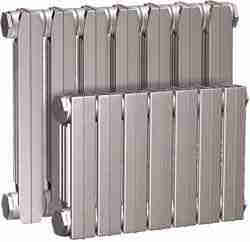
Thermal power is determined by the difference between these indicators. And if at a coolant temperature of 70 ° C, the difference was 50, we can say that the power of 1 section of the MC 140 cast-iron radiator is exactly 150 W.
First of all, this is due to the fact that exactly such a temperature regime is taken into account, at which a constant air temperature in the room will always be maintained at 20 ° C. In addition, heating takes place taking into account the properties of cast iron, which do not differ in high heat transfer rates.
Easy way to calculate
If everything is difficult with the calculations, you can resort to more easy way and take advantage of many years of experience for those who already use such radiators. A 15 m² room requires a 10-section radiator.
However, it should be noted that there should be one window in the room. For each subsequent section, it will be necessary to add more sections, the amount depends on the design of the window opening itself, the material from which it is made, the number of chambers in the glass unit and other factors. But, as a rule, 1 or 2 more sections are added, as a result, the price of the equipment increases.
Advice: when the area of \u200b\u200bthe room exceeds 20 m², there should be several radiators.
Moreover, they should be installed in different places, since even having increased a certain number of sections, the situation will not improve.
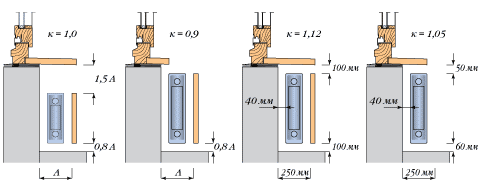
The main qualities of cast iron radiators
Selection is done in two ways:
- convection;
- radiant energy.
They are capable of creating a thermal curtain, therefore it is recommended to install them under windows, from where the cold comes.
However, the power of one section of the MC 140 cast-iron radiator is not the main indicator of the device's reliability. For example, aluminum and bimetallic radiators are more heat dissipated, but they have a much shorter service life.
Perhaps this was the reason that cast iron models are still in demand. You must admit that in no old building you will not find aluminum batteries, but there are as many cast-iron ones installed in the past centuries.
The opinion of many people agrees that a large amount of heat carrier required for them is very uneconomical and leads to excessive consumption of energy required to heat it. But this is just a delusion, the more coolant is contained in the device, the more it gives off heat.

In addition, if for some reason the supply of the coolant stops, the cast-iron battery will retain heat transfer for a long time, which is explained by both the properties of the material and the large volume of hot water that it contains. The only drawback of devices is their high inertness, which contributes to too slow heating, all other problems are quite solvable.
Conclusion
During its long operation, cast-iron models of radiators have shown themselves only on the good side. Today, not only standard models of such devices are in demand, but also modern ones.
The only drawback is a large mass, so they can be installed with their own hands only on a main wall or on the floor. The video in this article will allow you to find additional information on the above topic.
Another article in the heading - "apartment consumption". So, as the heating season has already begun, many are interested in the power of their batteries. Indeed, the heat in the room and in the apartment as a whole depends on the power (you need to know this when calculating heating radiators at the level of designing a heating system). Today I will talk about the power of 1 section of a cast iron radiator ...
Cast iron radiators come in various brands, but there are not so many of them and they can be listed on one hand. Everything else is just a variation of them. Today the most basic.
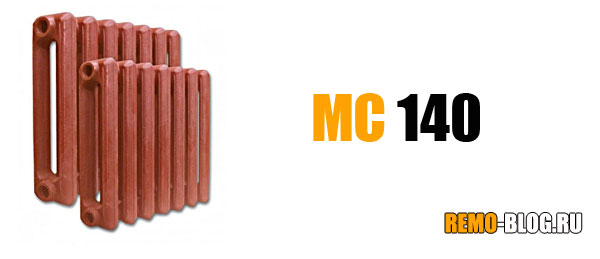
The classic and most common radiator is installed in many apartments in our country, as well as in many post-Soviet countries. Section width 140 mm, height (between supply pipes) 500 mm. Additional marking MC 140 - 500. The power of 1 section of this radiator is 175 W of thermal energy.
However, there are many variations of this radiator
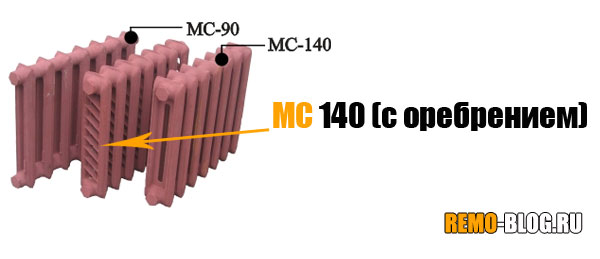
The most energy efficient version of the MC 140 radiator. The point is that additional cast iron ribs are installed between the sections, which also provide additional heating to the room. The power of such a radiator is 195 W of thermal energy (which is 20 W more than that of the classic MC 140). However, such radiators have a significant drawback, you need to monitor the frequency of these fins, if they get clogged (for example, with dust), then the thermal efficiency drops by 30 - 40 W!
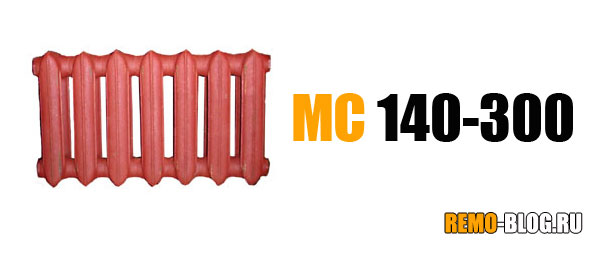
As the name implies, this radiator has the same width of 140 mm, but the height is only 300 mm. This is a compact type of radiator. The power of one section is only 120 W of thermal energy.
MC 90 - 500
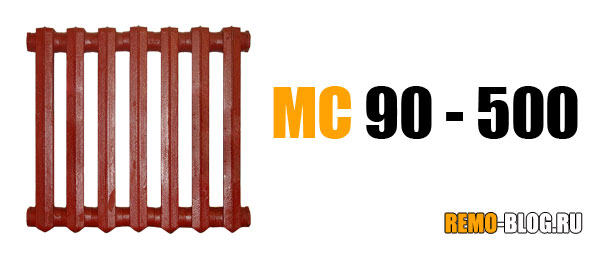
Less common radiator, but cheaper than the previous model. The width of one section is 90 mm (more compact), the height is the same 500 mm, hence the name. Less efficient than MC 140, the power of one section of such a radiator is about 140 W of thermal energy.
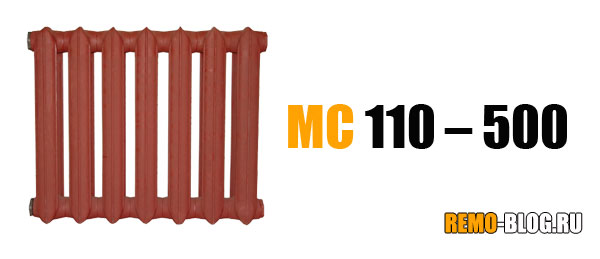
Cast iron radiator 110 mm wide and 500 mm high between pipes. Relatively rare was not set very often. Power of one section, about - 150 W

A relatively new development, a modified form. The radiator has a section width of 100 mm and a height (between the supply pipes 500 mm). Thermal power of one section - 135 - 140 W.

It is not uncommon now to see modern cast-iron radiators, produced by both import companies and our domestic ones. In appearance they are somewhat similar to aluminum radiators. The power of 1 section of such a radiator ranges from 150 to 220 W, much depends on the size of the radiator.
And that's all, I think I gave you the layout of the usual cast-iron radiators. Of course, the power can jump a little from manufacturer to manufacturer, but approximately the power is kept within these limits.
Heating radiator models and locations are selected at the stage of planning a house or apartment. Owners of private houses have to make this choice on their own. Unfortunately, for the majority of apartment residents, this issue is resolved by developers. It is much more difficult to heat a panel apartment. Heat transfer from cast iron radiators plays an important role in the choice of such devices. What type of device should you choose: aluminum, bimetallic or cast iron?
It is not surprising that when choosing, rarely anyone is guided by effective indicators of devices and economic characteristics. Choosing the most affordable device from a price point of view is not very correct. To begin with, it is recommended to pay attention to such an indicator as the heat transfer of heating radiators.
This will depend on the type and quality of the material used in the manufacture of the radiators. The main varieties are:
- cast iron;
- bimetal;
- made of aluminum;
- of steel.
Each of the materials has some disadvantages and a number of features, therefore, to make a decision, you will need to consider the main indicators in more detail.
Made of steel
They function perfectly in combination with an autonomous heating device, which is designed to heat a substantial area. Choice steel radiators heating is not considered an excellent option, since they are not able to withstand significant pressure. Extremely resistant to corrosion, light and satisfactory heat transfer performance. Having an insignificant flow area, they rarely clog. But the working pressure is considered to be 7.5-8 kg / cm 2, while the resistance to possible water hammer is only 13 kg / cm 2. The heat transfer of the section is 150 watts.
Jpg "alt \u003d" (! LANG: steel radiator" width="401" height="355">!} 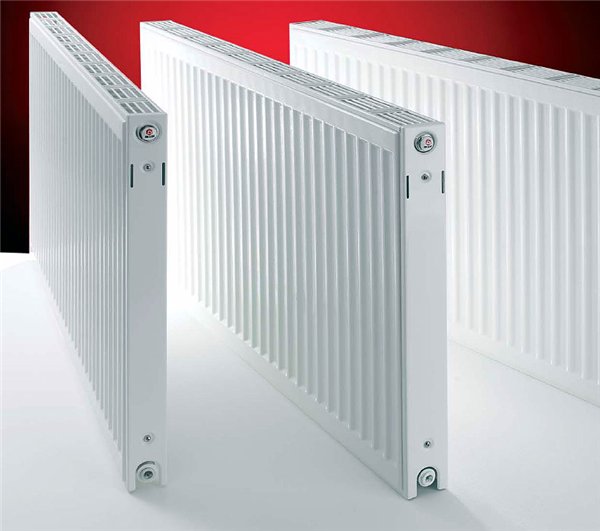 Steel
Steel
Made of bimetal
They are devoid of the disadvantages that are found in aluminum and cast iron products. The presence of a steel core is a characteristic feature, which made it possible to achieve a colossal pressure resistance of 16 - 100 kg / cm 2. The heat transfer of bimetallic radiators is 130 - 200 W, which is close to aluminum in terms of performance. They have a small cross-section, so over time, there are no problems with pollution. The significant disadvantages include the prohibitively high cost of products.
Jpg "alt \u003d" (! LANG: bimetal radiator" width="475" height="426">!} 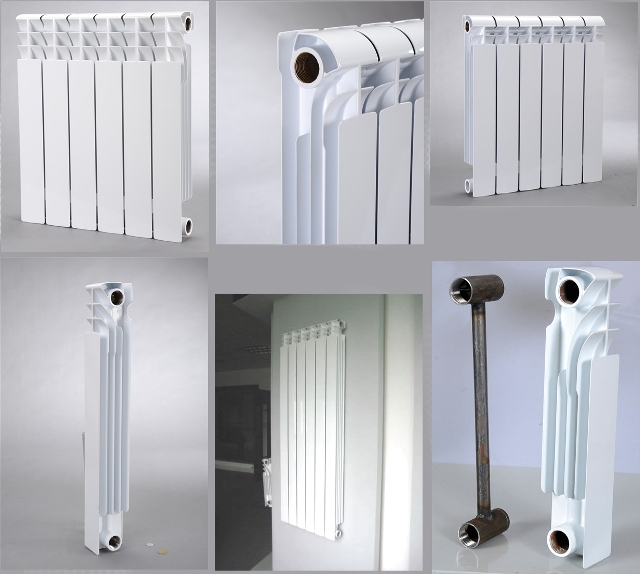 Bimetallic
Bimetallic
Made of aluminum
Such devices have many advantages. They have excellent external characteristics, moreover, they do not require special maintenance. Strong enough to avoid water hammer fears, as is the case with cast iron products... Working pressure is considered to be 12 - 16 kg / cm 2, depending on the model used. The features also include the flow area, which is equal to or less than the diameter of the risers. This allows the coolant to circulate inside the device at a tremendous speed, which makes it impossible for sediment deposition on the surface of the material. Most people mistakenly believe that too small a cross section will inevitably lead to a low heat transfer rate.
Jpg "alt \u003d" (! LANG: Aluminum radiator" width="564" height="423" srcset="" data-srcset="https://tepliepol.ru/wp-content/uploads/2017/06/aluminiy..jpg 360w, https://tepliepol.ru/wp-content/uploads/2017/06/aluminiy-80x60.jpg 80w" sizes="(max-width: 564px) 100vw, 564px">!} 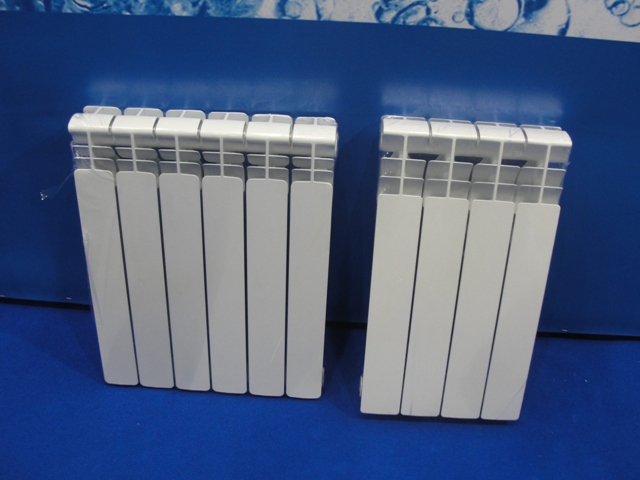 Aluminum
Aluminum
This opinion is erroneous, if only because the level of heat transfer from aluminum is much higher than, for example, from cast iron. The section is compensated by the ribbing area. Heat dissipation of aluminum radiators depends on various factors, including the model used and can be 137 - 210 W. Contrary to the above characteristics, it is not recommended to use this type of equipment in apartments, since the products are not able to withstand sudden temperature changes and pressure surges inside the system (during the run of all devices). Material aluminum radiator it breaks down very quickly and cannot be restored later, as in the case of using other material.
Made of cast iron
The need for regular and very careful maintenance. A high inertness rate is almost the main advantage of cast iron heating radiators. The heat dissipation level is also good. Such products do not heat up quickly, while they also give off heat for a long time. The heat transfer of one section of a cast-iron radiator is equal to 80 - 160 W. But there are a lot of shortcomings here, and the following are considered to be the main ones:
- Perceptible weight of the structure.
- Almost complete lack of ability to resist water hammer (9 kg / cm 2).
- A noticeable difference between the cross-section of the battery and the risers. This leads to a slow circulation of the coolant and a fairly rapid pollution.

Heat transfer calculation
First of all, it is recommended to pay attention to the available data sheet, which is attached to each product of this type. In it you can find the necessary information regarding the heat output of one section of the product. These figures require significant adjustments. The heat dissipation of bimetallic radiators, like aluminum ones, has excellent power ratings, while the judgment is based on the well-known fact that copper products have an excellent level of heat transfer, as do aluminum ones. They have a high thermal conductivity, while heat transfer depends on many other factors.
Jpg "alt \u003d" (! LANG: Calculation of the heat transfer coefficient" width="544" height="146">!}  The heat dissipation of the heating radiator is multiplied by the correction factor adopted depending on the DT value
The heat dissipation of the heating radiator is multiplied by the correction factor adopted depending on the DT value
The figure indicated in the passport is correct only if the difference between the supply and processing temperatures is 70 ° C.
Using the formula, calculations are made as follows:
The instruction may have various designations Often, only a difference of 70 ° C is mentioned and no more.
Calculation methodology
As a result, it turns out that the declared heat transfer of the batteries and the power is slightly lower than the real one, which is indicated in the documentation. For the right choice equipment must clearly understand the difference in these numbers. The components used will also play a secondary role, be it a copper or bimetallic element. To check the data, a reduction factor should be used that is applicable to the original power rating of the device as indicated in the documentation.
The calculation is done with the following sequence:
- To begin with, it is necessary to develop an optimal temperature regime in the premises and the main coolant.
- Substitute the collected information and calculate the delta as the average of the indicator.
- Find the most approximate indicator in the attached table.
- The resulting figure is multiplied by the one given in the documentation.
- Calculation is done the required amount heating devices.
It is also worth considering that the heating season sometimes comes earlier than usual and the device must be ready for use. For bimetallic equipment, the calculation will be as follows: 200 W x 0.48 - 96 W. If the area of \u200b\u200bthe room is 10 m2, then at least a thousand watts of heat will be needed or 1000/96 \u003d 10.4 \u003d 11 batteries or sections (rounding always goes up). In any case, there is always the opportunity to seek help from professionals who will help make the necessary calculations, and will tell you in detail how and why this is done. Good luck in your endeavors!



